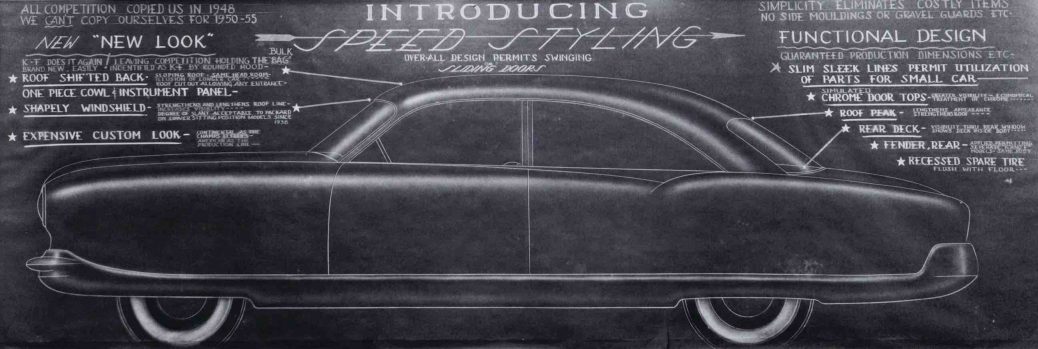
Kaiser Capers: Memories of Howard A. “Dutch” Darrin, Part 3
Kaiser-Frazer, the postwar wonder company, presented Dutch Darrin with many opportunities—and as many frustrations. Concluded from Part 2…
Part 3
Excerpt: For the complete article and illustrations, refer to The Automobile, May 2017.
Postwar Kaiser and Frazer
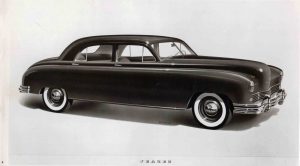
Dutch had an earthy vocabulary, and his methods of work were forthright with a touch of recklessness. He needed these qualities when, after the war, he presented himself to his old friend Joe Frazer, father of the wartime Jeep, to offer designs for the all-new cars Frazer was planning, in partnership with Henry J. Kaiser.
His basic lines were accepted, but modified on the way to production. Dutch furiously quit, saying the engineers “bent the goddam thing all out of shape,” and demanding his name, which K-F had agreed to put on every production car, be removed. Nevertheless, those early Frazers and Kaisers, different in many ways, offered the first straight-through fender line in a production automobile.
Dutch’s Seminal ’51 Kaiser
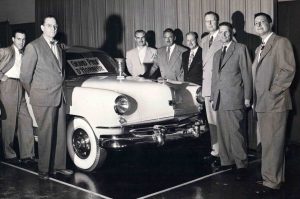
In 1948 they needed a new design, and Dutch returned to introduce “Speed-Styling,” on what he called the “Constellation.” A fresh approach in automotive architecture, its ultra-low aspect was achieved by new departures —a spare tire mounted under the trunk floor, curved doors extending into the roof, a chassis contour allowing a much lower rear seat, unprecedented glass area.
At Kaiser-Frazer, designers Duncan McRae and Herb Weissinger sculpted the final lines. Bob Robillard, E.H. Daniels and Buzz Grisinger contributed design details, Carleton Spencer some vivid interiors. Chief engineer Ralph Isbrandt, under Engineering chief H.V. Lindbergh, gave it fine handling and a smooth ride.
Unfortunately, those beautiful cars were powered by sixes not V-8s, and sales suffered as time went on through their lack of performance. The shape, however, endured. A handsome facelift carried it into 1955—and then from 1958 through 1962, when Kaiser car production moved to Argentina. That was quite a long life for any car design in the Fifties and Sixties.
Kaiser-Darrin sports car
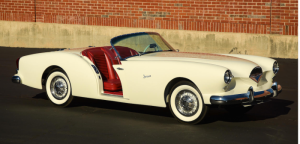
When left to himself, Dutch was capable of producing sensational shapes, but they weren’t always entirely practical. Perhaps today, with modern materials and servo-assists, the Kaiser-Darrin’s famous sliding doors would work better. Even then, the shape wasn’t right. They didn’t fit people with long legs, and folk of all sizes found it difficult to exit and enter.
The Kaiser Darrin DKF-161, to use its formal name, was nevertheless a dramatic piece of styling. Compared to the first Corvette, which appeared around the same time, it was sleeker, cleaner, uncluttered.
Like the Corvette its body was fiberglass, and like the first Corvette it was underpowered, by a little Willys F-head six. But as a design statement it was sensational. Sadly, by the time they got into production, the company was headed for oblivion. Only 435 Kaiser Darrins were built. The vast majority have survived.
To Henry Kaiser’s credit, he did insist on including “Darrin” in the sports car’s name—as he had granted the use of a little plaque, reading “Darrin Styled,” on the early 1947-48 cars and 1951 Kaiser. Designer Raymond Loewy’s name never appeared on his automobiles, Dutch bragged. “He asked me how I was able to do it. Actually it was thanks to a very generous contract Joe Frazer had written for me early on.”
Last thoughts
Early after the war, Darrin designed an all-new body for the homely Crosley, but Powell Crosley never wanted to spend the money. Finally he was involved in designing what became the Jeep Wagoneer—a big success for Jeep Corporation, which made up nicely for the sad failure of Kaiser-Frazer.
Pushing seventy, he wandered into Automobile Quarterly one day and began to reminisce. Gradually the light dawned. “Are you by any chance Howard Darrin?” editor Don Vorderman asked. Yes, it was he. “Wait, let me fetch a tape recorder!”
Don began reciting what he thought he knew about who created which great cars, and Dutch would sometimes take adamant exception. He never hid his light under a bushel, and if writers altered his version of automotive history, he was happy to lend them a piece of his mind.
“We Happy Few”

In the Seventies I had the opportunity to work closely with Darrin over my first book, on that same postwar company where Dutch had had so many triumphs and disappointments. It was sometimes exasperating; it was never dull. He had very firm ideas about automotive architecture and his role in it. On these he sailed confidently forward, and once arrived in his port of conclusion, no attack was sufficient to dislodge him.
Dutch was a man of striking contrasts—funny and serious, reckless and capable, diplomatic and headstrong, inspired, complex, vastly talented. If there was one quality which set him off from others in his trade, it was his characteristic way of standing back and looking at himself as he hoped history would. “How will I look if I do this?” he seemed to ask himself. He was always looking around for finest hours, and if one was not immediately available, his impulse was to create one. In the process, he gave us some of the most beautiful cars in the world.
Above all, of course, Dutch was supremely fortunate. The most warming thing about him was that he never ceased to say so. “Whomever thought that a dumb kid like me would fall into the strawberry patch?” he said. “I can describe my life in one word—happy. I’ve spent it doing the three things I most enjoy: building cars, flying airplanes and playing polo. Combine that with being married to a terrific woman—and what more can any man ask?”
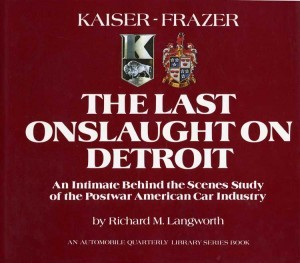 We happy few who knew him all remember some incident, a kindness graced with the courtesy of a past generation, going far beyond the normal calls of acquaintanceship. In the midst of all the tributes paid to him, I know the epitaph Dutch would have chosen for himself: “He was a good automobile man.”
We happy few who knew him all remember some incident, a kindness graced with the courtesy of a past generation, going far beyond the normal calls of acquaintanceship. In the midst of all the tributes paid to him, I know the epitaph Dutch would have chosen for himself: “He was a good automobile man.”
More Darrin
Part 1: “All the Luck: Howard A. ‘Dutch’ Darrin,” 2017.
“Part 2: The Packard Adventures of Dutch Darrin,” 2017.
“Kaiser-Frazer and the Making of Automotive History,” 2019.







2 thoughts on “Kaiser Capers: Memories of Howard A. “Dutch” Darrin, Part 3”
Neat article…in my garage I have 4 prints on the wall….each print has 3 incredible cars that I am sure that he worked on…many years ago the wife and I drove down to Santa Monica…and Dutch signed each one.
What a great article on my dad!
Comments are closed.